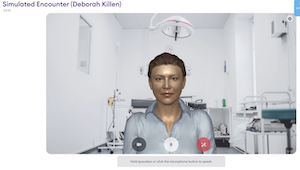
Students at the medical school have one more tool in their toolbox to learn clinical skills thanks to a new technology in WMed’s state-of-the-art Simulation Center.
The medical school is piloting a program that uses chat bots with artificial intelligence built by UK-based company Recourse Medical to simulate patient encounters to help second-year medical students learn clinical skills. Students can interact with the bot to simulate an in-person patient encounter, including asking the bot why he or she needs care and understanding the bot’s symptoms and medical history.
Currently, the medical school has two different cases that second-year students started interacting with in February. The medical school is working with Recourse Medical to develop the technology to be able to order medical tests and get test results, said Dr. Michael Busha, the medical school’s associate dean for Educational Affairs.
“This isn’t purchasing something that someone else developed,” Dr. Busha said. “We’re actually developing this in house from a case standpoint and developing it to meet our needs.”
Students have lost access through the COVID-19 pandemic to standardized patients and have had decreased access to learn clinical skills, so medical school leaders wanted to explore the technology, Dr. Busha said.
“There are always opportunities to better increase clinical reasoning and patient skills development,” Dr. Busha said. “We saw this as a reason to complement what we do in the Simulation Center and the clinical environment.”
This new technology is a complement to the medical school’s standardized patient program but is something that students can do virtually and asynchronously, said Adam Channell, PhD, an assistant professor in the medical school’s Department of Medical Education. The medical school’s 24,000-square-foot Simulation Center at the W.E. Upjohn M.D. Campus includes a 13-bed virtual hospital with a large operating room and debriefing rooms, a 12-room ambulatory clinic, two control rooms, procedure labs, classrooms, an ultrasonography suite and a virtual endoscopic surgery room.
“We’re attempting to implement something in addition to the traditional in-person standardized patient experience for students,” Dr. Channell said. “Having a new asynchronous tool in the toolbox will help not only our current situation with the COVID-19 pandemic, but also for the future. The goal is to provide more flexibility for independent learning for our students.”
